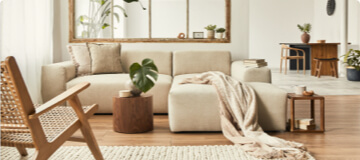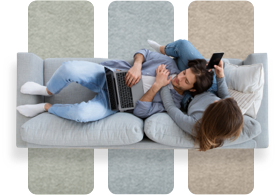Affordable, durable, and easy to clean, laminate flooring is a popular choice in both residential and commercial buildings. However, as one of the harder flooring options available, laminate flooring is prone to carrying slightly more noise than softer flooring alternatives like vinyl or carpet.
In this guide to soundproofing under laminate flooring, we discuss the benefits of soundproofing under laminate flooring, as well as the options you have to choose from to ensure your home or workspace remains as quiet as possible.
Why you should consider soundproofing under laminate flooring
When it comes to soundproofing under laminate flooring, there are two types of noise you’re trying to reduce:
- Impact noise, which is created when one object hits another object. In the case of flooring, this is commonly generated by footsteps, objects hitting the floor and furniture scraping along the floor. These noises not only echo around the room, but can travel through the floor and into rooms or apartments below.
- Airborne noise, which travels through the air and is generated by things such as the television, people talking, and dogs barking.
Just like timber flooring, laminate flooring is considered a relatively hard type of flooring. This means that without proper soundproofing, laminate flooring can cause both impact noise and airborne noise to echo more than softer flooring alternatives such as vinyl and carpet. This is particularly important to consider in an apartment, where noise can travel to downstairs neighbours.
If you’ve ever moved house you’ll be familiar with how much noisier a room is when there is nothing in it to absorb the soundwaves. Much like filling a room with furniture reduces the amount of noise that bounces around the room, the goal of soundproofing under laminate flooring is to dampen these noises by absorbing the sound waves and preventing them from travelling further.
Best types of soundproofing under laminate flooring
Soundproofing under laminate flooring is an effective way to both limit the amount of impact noise that is generated from objects hitting the floor and absorb everyday noises that travel through the air.
Generally speaking, ‘acoustic underlay’ is used for soundproofing under laminate flooring. It is simply a floor underlay, typically made of foam, rubber or cork, that is placed between the subfloor and the floor to absorb soundwaves. There are a wide variety of acoustic underlays available, with each option differing in material type, density and thickness depending on your soundproofing requirements.
Some common acoustic underlays specifically designed for use with laminate flooring include:
- 2mm Green Acoustic Underlay, which is a common, inexpensive underlay designed specifically for floating laminate floors. It has an AAAC rating of four stars.
- Dunlop’s range of hard flooring underlays, which are specifically designed for laminate and hardwood floors. Dunlop’s Aquacoustic, Timbermate, Thermacoustic and Timbercushion are each made from polyethylene foam and a moisture barrier, while their Advantage 3 underlay is made from recycled rubber and cork.
- Regupol’s range of predominantly recycled rubber flooring underlays, including their Sonus Core range.
When selecting an acoustic underlay it is important to talk to your flooring specialist and ensure that the underlay meets the relevant acoustic requirements for your building. For instance, when you’re soundproofing the flooring in an apartment, you will typically need to select an acoustic underlay with an AAAC rating of five or above to ensure your flooring meets the relevant acoustic standards set out by the National Construction Code.
Benefits of soundproofing under laminate flooring
In addition to dampening noise, soundproofing under laminate flooring has a range of other benefits. Specifically, acoustic underlay can:
- Provide a layer of insulation, helping to keep your house warm in winter and cool in summer.
- Make your floor more comfortable to walk on by providing a degree of cushioning.
- Prevent moisture from seeping into your laminate boards.





